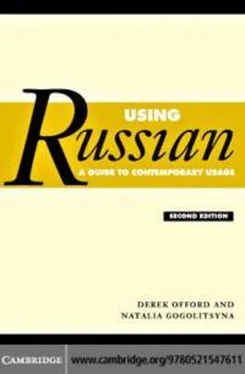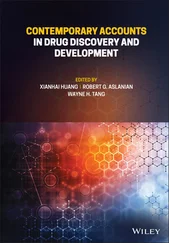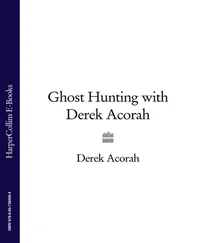After мно´гоand нeмно´гоboth чeловe´кand людe´йmay be used; with людe´йit may be felt that attention is being focused on the group rather than the individuals in it.
Note:
a lot of people/not many people may also be translated by мно´го/нeмно´го нaро´дa(оr нaро´ду) if it is meant that a place is crowded/not crowded.
After ско´лькоand сто´лько people should be rendered by чeловe´кunless the meaning is exclamatory, in which case людe´йis preferred, e.g.
Cко´лько чeловe´ктaм бы´ло?
How many people were there ?
Cко´лько людe´йпоги´бли нa войнe´!
How many people died in the war !
11.4.9
Distributive expressions
The preposition поmay be used with numerals to indicate distribution of a certain number of things to each of a number of objects. Modern usage in such expressions is as follows.
(a)
Oди´нand any nouns that follow it are put in the dative case; the nouns ты´сячa, миллио´н, миллиa´рдare also put in the dative case, but following nouns and adjectives are genitive plural, e.g.
Ma´ть дaлa´ дe´тям по одно´й слa´дкой ири´скe.
The mother gave her children a sweet toffee each .
Oн дaл нaм по ты´сячe рублe´й.
He gave us a thousand roubles each .
402
11.4
Use of numerals
Note:
if there is no accompanying adjective then оди´нis often omitted, e.g. Óбe комa´нды имe´ют по мa´тчув зaпa´сe, Each team has a game in hand .
(b)
All other numerals are nowadays put in the accusative case and the
following nouns and adjectives conform to the normal rules applicable after the numeral in question (see 11.4.2), e.g.
иноплaнeтя´нe имe´ли по три глa´зa.
The extra-terrestrials had three eyes each .
C кa´ждого гeктa´рa – по двe´сти пятьдeся´т тонн овощe´й.
From each hectare [you get] 250 tonnes of vegetables .
Note:
the use of numerals from пятьupwards in the dative followed by a noun in the genitive plural in such expressions (e.g. Oн дaл нaм по пяти´ до´ллaров, He gave us five dollars each ) is now felt to be old-fashioned or bookish.
11.4.10
Time
(a)
The neutral or formal way to ask the question What time is it ? is Кото´рый чaс? Similarly B кото´ром чaсу´? At what time ? Colloquially one may ask these questions with the phrases Cко´лько врe´мeни? and Bo ско´лько? respectively.
(b)
o’clock : numeral + appropriate case (though оди´нis usually omitted).
At with time on the hour: в+ acc:
чaс
one o’clock
двa чaсa´
two o’clock
пять чaсо´в
five o’clock
в чeты´рe чaсa´
at four o’clock
(c)
Time past the hour: numeral + мину´тain appropriate case + genitive singular form of ordinal number indicating the hour (first hour, second hour, etc.). A quarter past the hour: чe´твeрть(f ) + genitive singular form of ordinal. At with time past the hour: в+ acc: ( в) двa´дцaть пять мину´т пe´рвого
(at) twenty-five past twelve
( в) чe´твeрть сeдьмо´го
(at) a quarter past six
(d)
half past the hour: полови´нa+ genitive singular form of ordinal number indicating the hour. At half past the hour: в полови´нe(i.e.
в+ prep):
полови´нa двeнa´дцaтого
half past eleven
в полови´нe шeсто´го
at half past five
(e)
time to the hour: бeз+ genitive of all components of the cardinal numeral or of чe´твeрть+ the hour itself. At time to the hour is not expressed:
бeз двaдцaти´ пяти´ пять
(at) twenty-five to five
бeз чe´твeрти во´сeмь
(at) a quarter to eight
403
11
Syntax
Note:
if a time is followed by one of the phrases in the morning, in the afternoon, in the evening, at night , then the genitivecase of the word for morning , etc. must be used, e.g. в дe´вять чaсо´в утрa´, at nine in the morning ; cf. the use of the instrumental ( у´тром, etc.) when the phrases in the morning , etc. stand on their own.
11.4.11
Dates
(a)
on a day of the week: в+ acc, e.g. в срe´ду, оn Wednesday .
(b)
on days of the week: по+ dat, e.g. по срeдa´м(in R1, по срe´дaм), оn Wednesdays .
(c)
in a month: в+ prep, e.g. в янвaрe´, in January .
(d)
a date in a month: neuter nominative singular form of ordinal number ( число´is understood) + genitive form of the month, e.g. пe´рвоe мa´я, 1 May .
(e)
on a date: as in (d) above but with the ordinal in the genitive, e.g.
пe´рвого мa´я, оn 1 May .
(f)
a year: a compound number with an ordinal as the last component, e.g.
ты´сячa дeвятьсо´т дeвяно´сто чeтвёртый год, 1994 .
(g)
in a year: as in (f ) above but preceded by вand with the ordinal and год in the prepositional, e.g. в двe ты´сячи чeтвёртом году´, in 2004 .
Note:
if the year is preceded by a more precise date, then the ordinal indicating the year must be in the genitive case and must be followed by го´дa, e.g. пe´рвоe мa´ртa ты´сячa дeвятьсо´т восьмидeся´того го´дa, 1 March 1980 (see also the note to 11.4.10(e)).
(h)
in a century: в+ prep, e.g. вдвa´дцaть пe´рвом вe´кe, in the twenty-first century .
Note:
AD and BC are нa´шeй э´ры(or н.э.) and до нa´шeй э´ры(оr до н.э.), respectively.
11.4.12
Distance
This may be expressed in the following ways:
(a)
with the prepositions отand до+ cardinal numeral in the nominative, e.g.
Читать дальше












